Analyzing Business Processes: Quality Management at Tesco
VerifiedAdded on 2023/01/11
|16
|5233
|23
Report
AI Summary
This report provides a comprehensive analysis of Tesco's business processes, focusing on quality management approaches and project success. It compares Tesco's quality management strategies with those of its competitor, Aldi, examining techniques like Total Quality Management, Six Sigma, and Le...
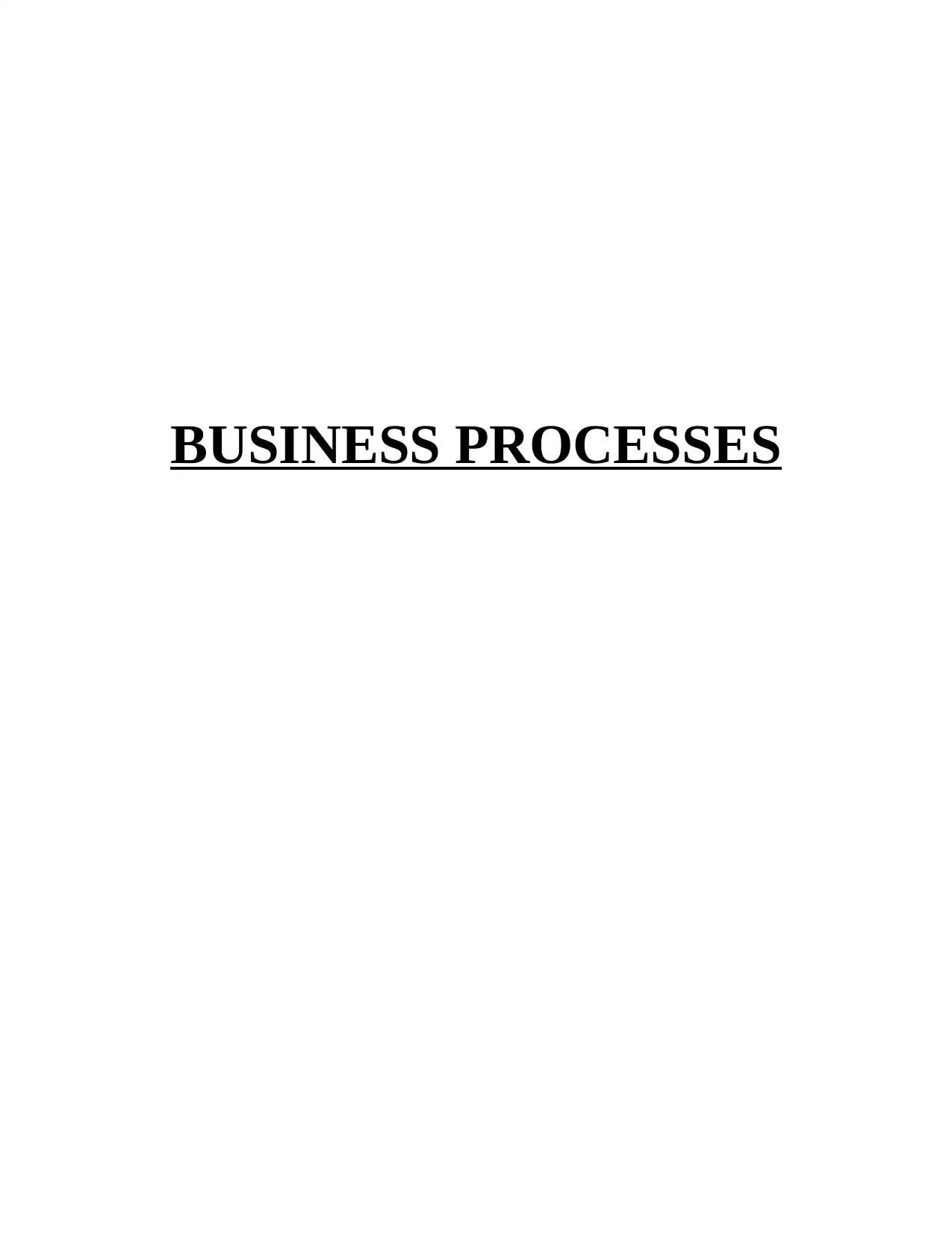
BUSINESS PROCESSES
Paraphrase This Document
Need a fresh take? Get an instant paraphrase of this document with our AI Paraphraser
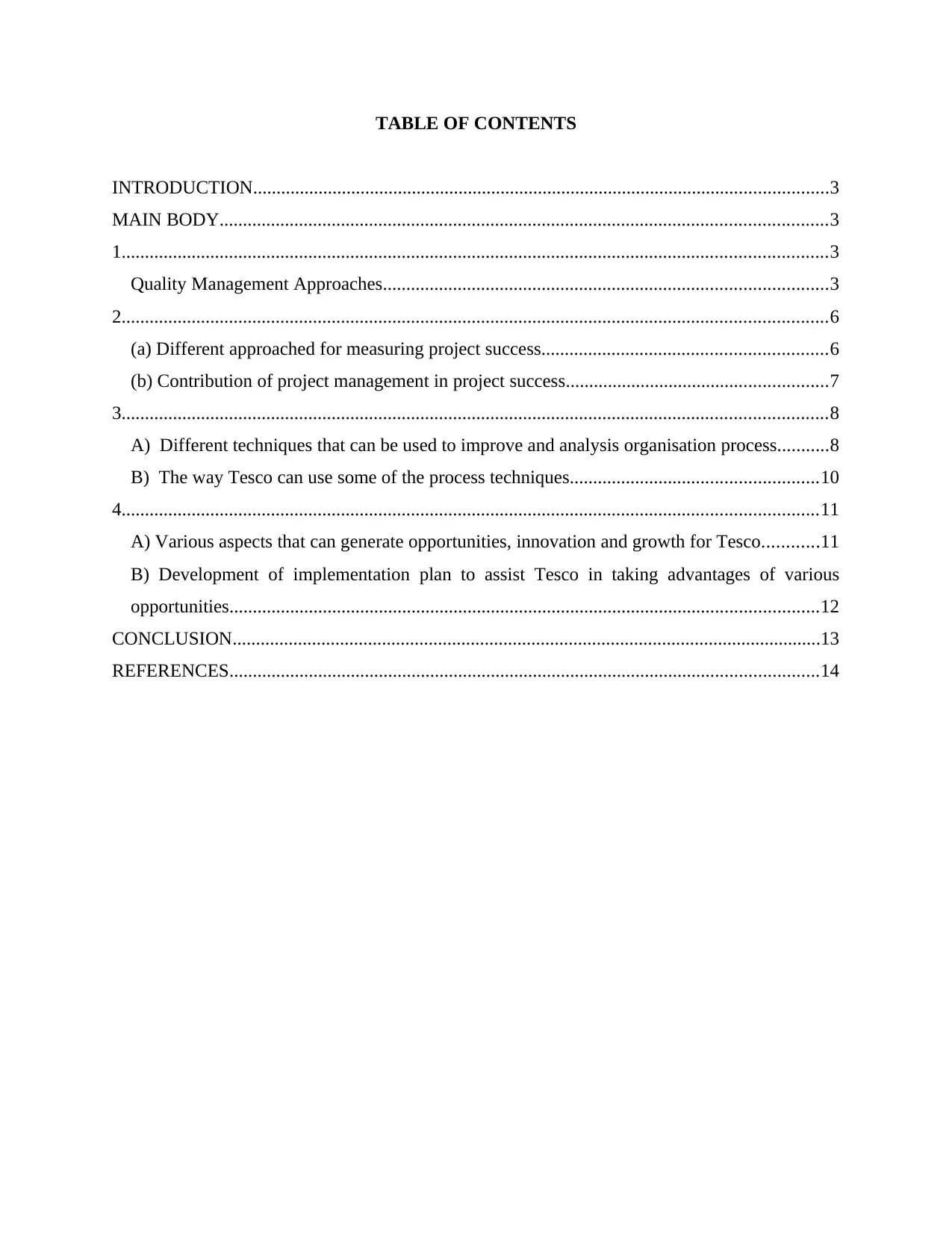
TABLE OF CONTENTS
INTRODUCTION...........................................................................................................................3
MAIN BODY..................................................................................................................................3
1.......................................................................................................................................................3
Quality Management Approaches...............................................................................................3
2.......................................................................................................................................................6
(a) Different approached for measuring project success.............................................................6
(b) Contribution of project management in project success........................................................7
3.......................................................................................................................................................8
A) Different techniques that can be used to improve and analysis organisation process...........8
B) The way Tesco can use some of the process techniques.....................................................10
4.....................................................................................................................................................11
A) Various aspects that can generate opportunities, innovation and growth for Tesco............11
B) Development of implementation plan to assist Tesco in taking advantages of various
opportunities..............................................................................................................................12
CONCLUSION..............................................................................................................................13
REFERENCES..............................................................................................................................14
INTRODUCTION...........................................................................................................................3
MAIN BODY..................................................................................................................................3
1.......................................................................................................................................................3
Quality Management Approaches...............................................................................................3
2.......................................................................................................................................................6
(a) Different approached for measuring project success.............................................................6
(b) Contribution of project management in project success........................................................7
3.......................................................................................................................................................8
A) Different techniques that can be used to improve and analysis organisation process...........8
B) The way Tesco can use some of the process techniques.....................................................10
4.....................................................................................................................................................11
A) Various aspects that can generate opportunities, innovation and growth for Tesco............11
B) Development of implementation plan to assist Tesco in taking advantages of various
opportunities..............................................................................................................................12
CONCLUSION..............................................................................................................................13
REFERENCES..............................................................................................................................14
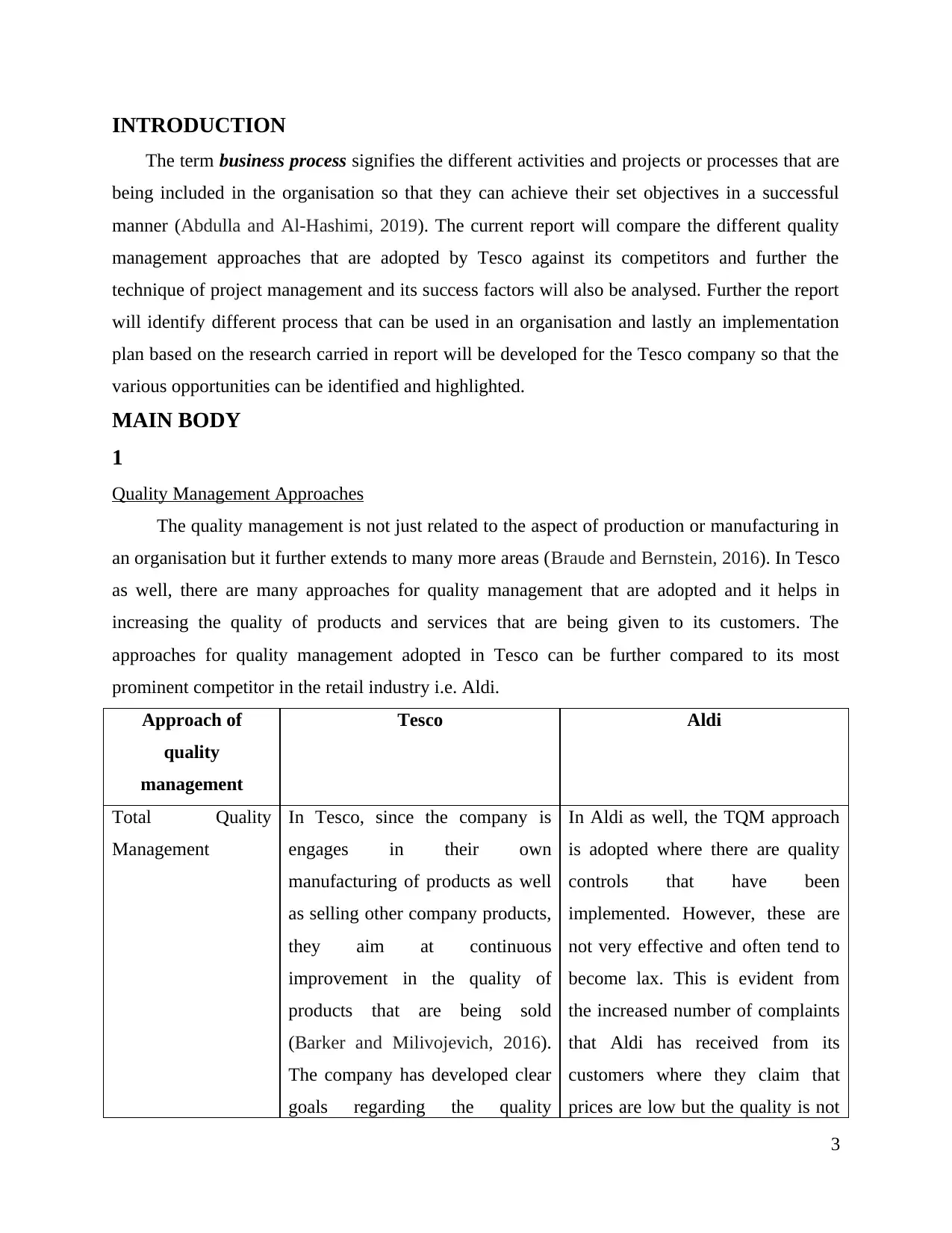
INTRODUCTION
The term business process signifies the different activities and projects or processes that are
being included in the organisation so that they can achieve their set objectives in a successful
manner (Abdulla and Al-Hashimi, 2019). The current report will compare the different quality
management approaches that are adopted by Tesco against its competitors and further the
technique of project management and its success factors will also be analysed. Further the report
will identify different process that can be used in an organisation and lastly an implementation
plan based on the research carried in report will be developed for the Tesco company so that the
various opportunities can be identified and highlighted.
MAIN BODY
1
Quality Management Approaches
The quality management is not just related to the aspect of production or manufacturing in
an organisation but it further extends to many more areas (Braude and Bernstein, 2016). In Tesco
as well, there are many approaches for quality management that are adopted and it helps in
increasing the quality of products and services that are being given to its customers. The
approaches for quality management adopted in Tesco can be further compared to its most
prominent competitor in the retail industry i.e. Aldi.
Approach of
quality
management
Tesco Aldi
Total Quality
Management
In Tesco, since the company is
engages in their own
manufacturing of products as well
as selling other company products,
they aim at continuous
improvement in the quality of
products that are being sold
(Barker and Milivojevich, 2016).
The company has developed clear
goals regarding the quality
In Aldi as well, the TQM approach
is adopted where there are quality
controls that have been
implemented. However, these are
not very effective and often tend to
become lax. This is evident from
the increased number of complaints
that Aldi has received from its
customers where they claim that
prices are low but the quality is not
3
The term business process signifies the different activities and projects or processes that are
being included in the organisation so that they can achieve their set objectives in a successful
manner (Abdulla and Al-Hashimi, 2019). The current report will compare the different quality
management approaches that are adopted by Tesco against its competitors and further the
technique of project management and its success factors will also be analysed. Further the report
will identify different process that can be used in an organisation and lastly an implementation
plan based on the research carried in report will be developed for the Tesco company so that the
various opportunities can be identified and highlighted.
MAIN BODY
1
Quality Management Approaches
The quality management is not just related to the aspect of production or manufacturing in
an organisation but it further extends to many more areas (Braude and Bernstein, 2016). In Tesco
as well, there are many approaches for quality management that are adopted and it helps in
increasing the quality of products and services that are being given to its customers. The
approaches for quality management adopted in Tesco can be further compared to its most
prominent competitor in the retail industry i.e. Aldi.
Approach of
quality
management
Tesco Aldi
Total Quality
Management
In Tesco, since the company is
engages in their own
manufacturing of products as well
as selling other company products,
they aim at continuous
improvement in the quality of
products that are being sold
(Barker and Milivojevich, 2016).
The company has developed clear
goals regarding the quality
In Aldi as well, the TQM approach
is adopted where there are quality
controls that have been
implemented. However, these are
not very effective and often tend to
become lax. This is evident from
the increased number of complaints
that Aldi has received from its
customers where they claim that
prices are low but the quality is not
3
You're viewing a preview
Unlock full access by subscribing today!
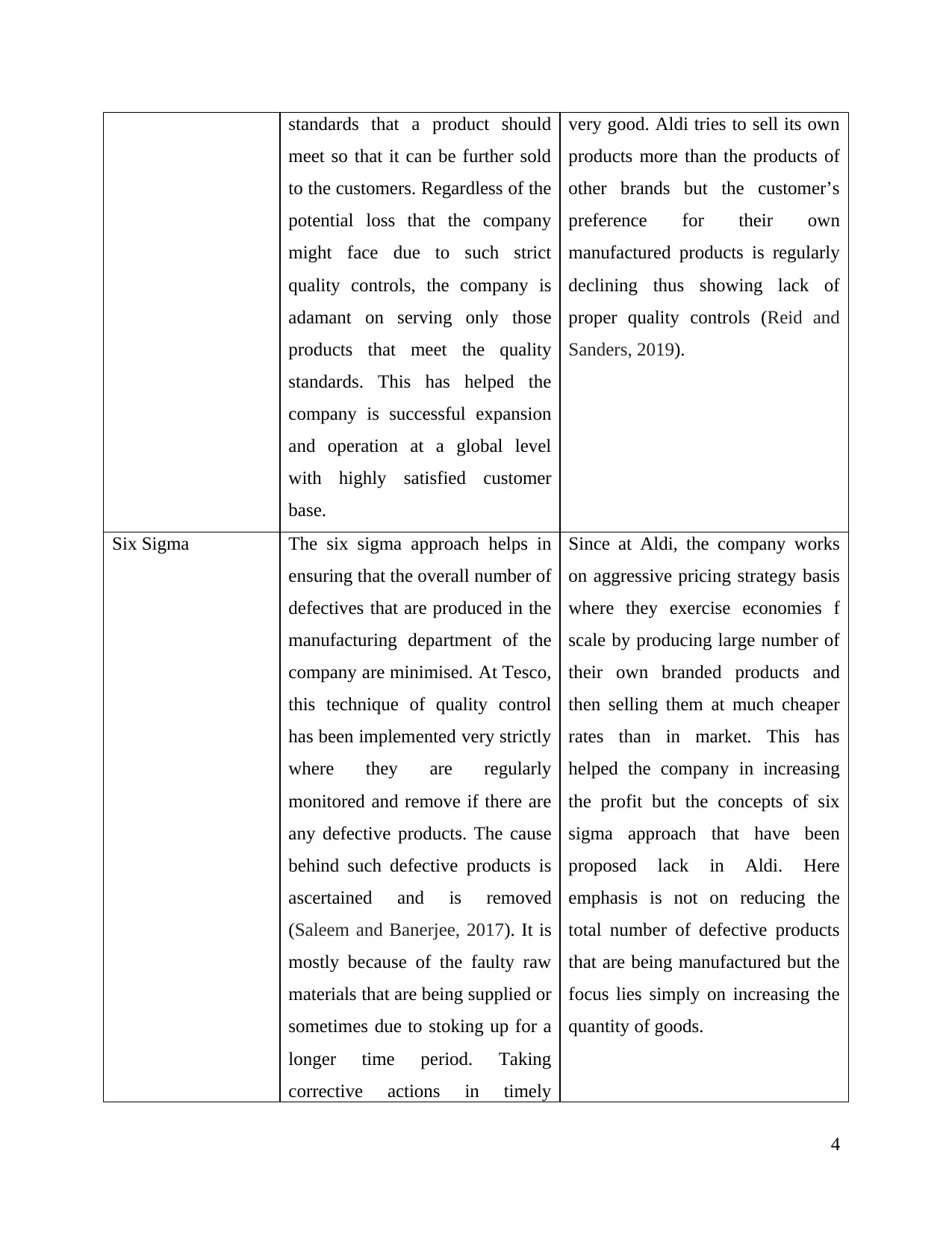
standards that a product should
meet so that it can be further sold
to the customers. Regardless of the
potential loss that the company
might face due to such strict
quality controls, the company is
adamant on serving only those
products that meet the quality
standards. This has helped the
company is successful expansion
and operation at a global level
with highly satisfied customer
base.
very good. Aldi tries to sell its own
products more than the products of
other brands but the customer’s
preference for their own
manufactured products is regularly
declining thus showing lack of
proper quality controls (Reid and
Sanders, 2019).
Six Sigma The six sigma approach helps in
ensuring that the overall number of
defectives that are produced in the
manufacturing department of the
company are minimised. At Tesco,
this technique of quality control
has been implemented very strictly
where they are regularly
monitored and remove if there are
any defective products. The cause
behind such defective products is
ascertained and is removed
(Saleem and Banerjee, 2017). It is
mostly because of the faulty raw
materials that are being supplied or
sometimes due to stoking up for a
longer time period. Taking
corrective actions in timely
Since at Aldi, the company works
on aggressive pricing strategy basis
where they exercise economies f
scale by producing large number of
their own branded products and
then selling them at much cheaper
rates than in market. This has
helped the company in increasing
the profit but the concepts of six
sigma approach that have been
proposed lack in Aldi. Here
emphasis is not on reducing the
total number of defective products
that are being manufactured but the
focus lies simply on increasing the
quantity of goods.
4
meet so that it can be further sold
to the customers. Regardless of the
potential loss that the company
might face due to such strict
quality controls, the company is
adamant on serving only those
products that meet the quality
standards. This has helped the
company is successful expansion
and operation at a global level
with highly satisfied customer
base.
very good. Aldi tries to sell its own
products more than the products of
other brands but the customer’s
preference for their own
manufactured products is regularly
declining thus showing lack of
proper quality controls (Reid and
Sanders, 2019).
Six Sigma The six sigma approach helps in
ensuring that the overall number of
defectives that are produced in the
manufacturing department of the
company are minimised. At Tesco,
this technique of quality control
has been implemented very strictly
where they are regularly
monitored and remove if there are
any defective products. The cause
behind such defective products is
ascertained and is removed
(Saleem and Banerjee, 2017). It is
mostly because of the faulty raw
materials that are being supplied or
sometimes due to stoking up for a
longer time period. Taking
corrective actions in timely
Since at Aldi, the company works
on aggressive pricing strategy basis
where they exercise economies f
scale by producing large number of
their own branded products and
then selling them at much cheaper
rates than in market. This has
helped the company in increasing
the profit but the concepts of six
sigma approach that have been
proposed lack in Aldi. Here
emphasis is not on reducing the
total number of defective products
that are being manufactured but the
focus lies simply on increasing the
quantity of goods.
4
Paraphrase This Document
Need a fresh take? Get an instant paraphrase of this document with our AI Paraphraser
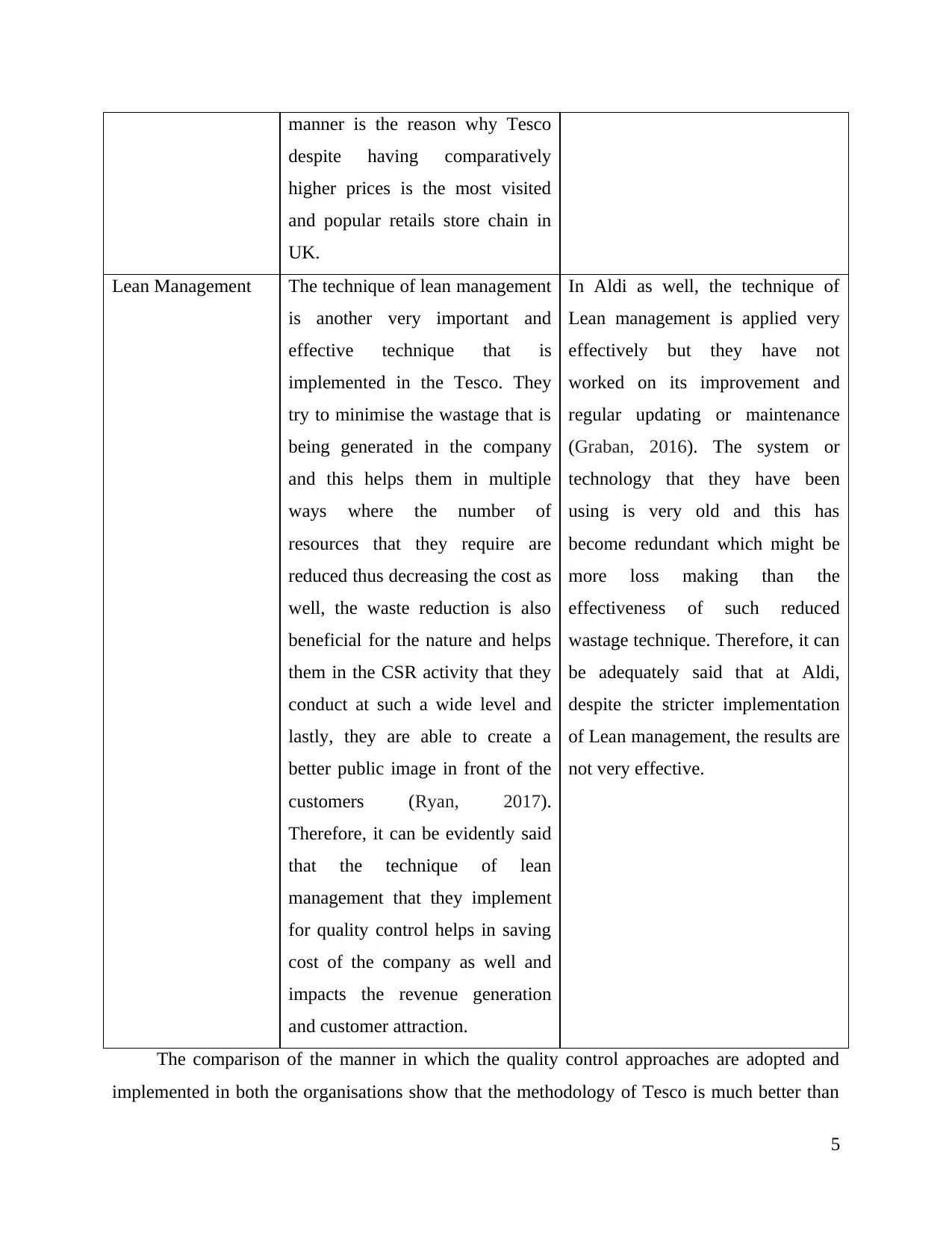
manner is the reason why Tesco
despite having comparatively
higher prices is the most visited
and popular retails store chain in
UK.
Lean Management The technique of lean management
is another very important and
effective technique that is
implemented in the Tesco. They
try to minimise the wastage that is
being generated in the company
and this helps them in multiple
ways where the number of
resources that they require are
reduced thus decreasing the cost as
well, the waste reduction is also
beneficial for the nature and helps
them in the CSR activity that they
conduct at such a wide level and
lastly, they are able to create a
better public image in front of the
customers (Ryan, 2017).
Therefore, it can be evidently said
that the technique of lean
management that they implement
for quality control helps in saving
cost of the company as well and
impacts the revenue generation
and customer attraction.
In Aldi as well, the technique of
Lean management is applied very
effectively but they have not
worked on its improvement and
regular updating or maintenance
(Graban, 2016). The system or
technology that they have been
using is very old and this has
become redundant which might be
more loss making than the
effectiveness of such reduced
wastage technique. Therefore, it can
be adequately said that at Aldi,
despite the stricter implementation
of Lean management, the results are
not very effective.
The comparison of the manner in which the quality control approaches are adopted and
implemented in both the organisations show that the methodology of Tesco is much better than
5
despite having comparatively
higher prices is the most visited
and popular retails store chain in
UK.
Lean Management The technique of lean management
is another very important and
effective technique that is
implemented in the Tesco. They
try to minimise the wastage that is
being generated in the company
and this helps them in multiple
ways where the number of
resources that they require are
reduced thus decreasing the cost as
well, the waste reduction is also
beneficial for the nature and helps
them in the CSR activity that they
conduct at such a wide level and
lastly, they are able to create a
better public image in front of the
customers (Ryan, 2017).
Therefore, it can be evidently said
that the technique of lean
management that they implement
for quality control helps in saving
cost of the company as well and
impacts the revenue generation
and customer attraction.
In Aldi as well, the technique of
Lean management is applied very
effectively but they have not
worked on its improvement and
regular updating or maintenance
(Graban, 2016). The system or
technology that they have been
using is very old and this has
become redundant which might be
more loss making than the
effectiveness of such reduced
wastage technique. Therefore, it can
be adequately said that at Aldi,
despite the stricter implementation
of Lean management, the results are
not very effective.
The comparison of the manner in which the quality control approaches are adopted and
implemented in both the organisations show that the methodology of Tesco is much better than
5
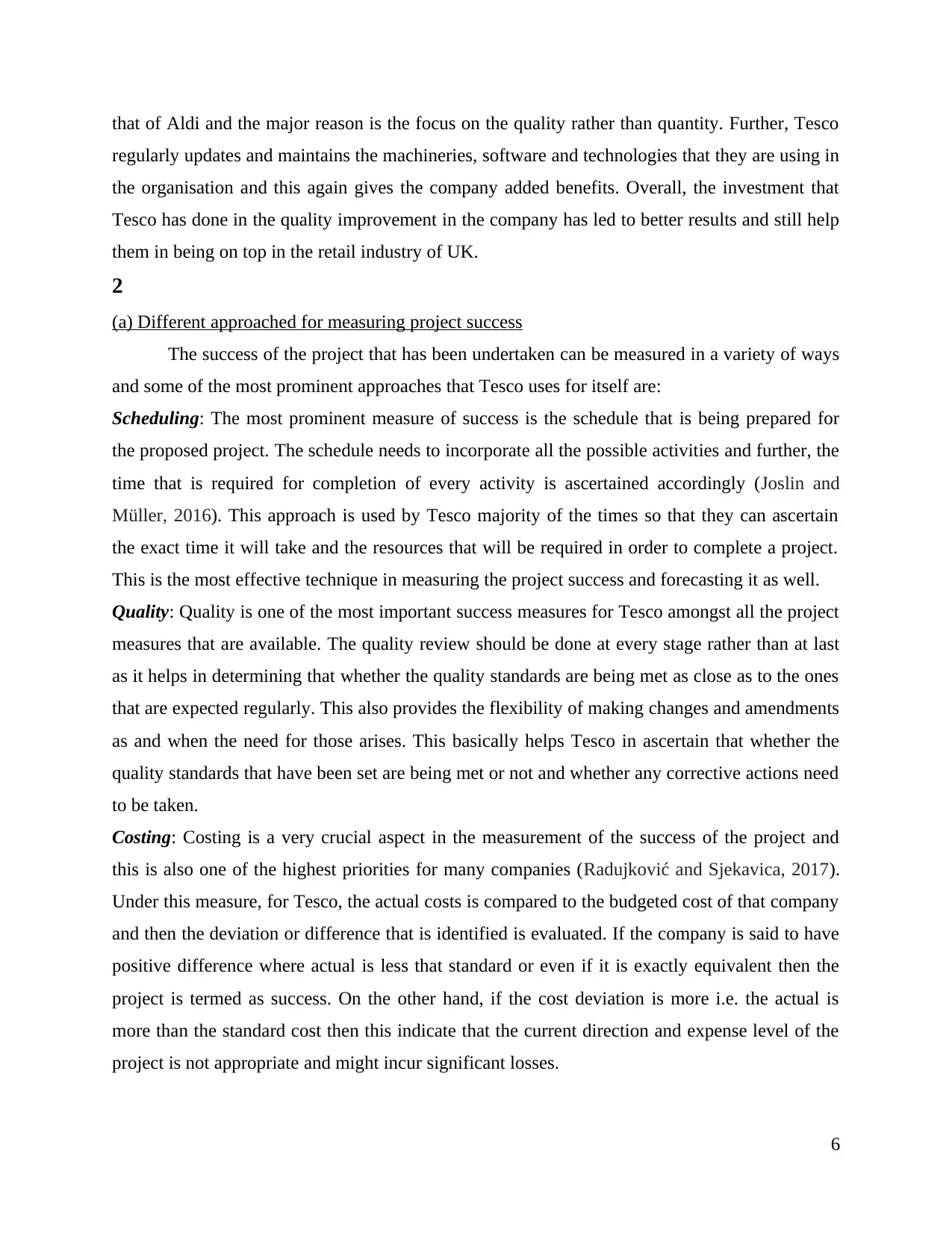
that of Aldi and the major reason is the focus on the quality rather than quantity. Further, Tesco
regularly updates and maintains the machineries, software and technologies that they are using in
the organisation and this again gives the company added benefits. Overall, the investment that
Tesco has done in the quality improvement in the company has led to better results and still help
them in being on top in the retail industry of UK.
2
(a) Different approached for measuring project success
The success of the project that has been undertaken can be measured in a variety of ways
and some of the most prominent approaches that Tesco uses for itself are:
Scheduling: The most prominent measure of success is the schedule that is being prepared for
the proposed project. The schedule needs to incorporate all the possible activities and further, the
time that is required for completion of every activity is ascertained accordingly (Joslin and
Müller, 2016). This approach is used by Tesco majority of the times so that they can ascertain
the exact time it will take and the resources that will be required in order to complete a project.
This is the most effective technique in measuring the project success and forecasting it as well.
Quality: Quality is one of the most important success measures for Tesco amongst all the project
measures that are available. The quality review should be done at every stage rather than at last
as it helps in determining that whether the quality standards are being met as close as to the ones
that are expected regularly. This also provides the flexibility of making changes and amendments
as and when the need for those arises. This basically helps Tesco in ascertain that whether the
quality standards that have been set are being met or not and whether any corrective actions need
to be taken.
Costing: Costing is a very crucial aspect in the measurement of the success of the project and
this is also one of the highest priorities for many companies (Radujković and Sjekavica, 2017).
Under this measure, for Tesco, the actual costs is compared to the budgeted cost of that company
and then the deviation or difference that is identified is evaluated. If the company is said to have
positive difference where actual is less that standard or even if it is exactly equivalent then the
project is termed as success. On the other hand, if the cost deviation is more i.e. the actual is
more than the standard cost then this indicate that the current direction and expense level of the
project is not appropriate and might incur significant losses.
6
regularly updates and maintains the machineries, software and technologies that they are using in
the organisation and this again gives the company added benefits. Overall, the investment that
Tesco has done in the quality improvement in the company has led to better results and still help
them in being on top in the retail industry of UK.
2
(a) Different approached for measuring project success
The success of the project that has been undertaken can be measured in a variety of ways
and some of the most prominent approaches that Tesco uses for itself are:
Scheduling: The most prominent measure of success is the schedule that is being prepared for
the proposed project. The schedule needs to incorporate all the possible activities and further, the
time that is required for completion of every activity is ascertained accordingly (Joslin and
Müller, 2016). This approach is used by Tesco majority of the times so that they can ascertain
the exact time it will take and the resources that will be required in order to complete a project.
This is the most effective technique in measuring the project success and forecasting it as well.
Quality: Quality is one of the most important success measures for Tesco amongst all the project
measures that are available. The quality review should be done at every stage rather than at last
as it helps in determining that whether the quality standards are being met as close as to the ones
that are expected regularly. This also provides the flexibility of making changes and amendments
as and when the need for those arises. This basically helps Tesco in ascertain that whether the
quality standards that have been set are being met or not and whether any corrective actions need
to be taken.
Costing: Costing is a very crucial aspect in the measurement of the success of the project and
this is also one of the highest priorities for many companies (Radujković and Sjekavica, 2017).
Under this measure, for Tesco, the actual costs is compared to the budgeted cost of that company
and then the deviation or difference that is identified is evaluated. If the company is said to have
positive difference where actual is less that standard or even if it is exactly equivalent then the
project is termed as success. On the other hand, if the cost deviation is more i.e. the actual is
more than the standard cost then this indicate that the current direction and expense level of the
project is not appropriate and might incur significant losses.
6
You're viewing a preview
Unlock full access by subscribing today!
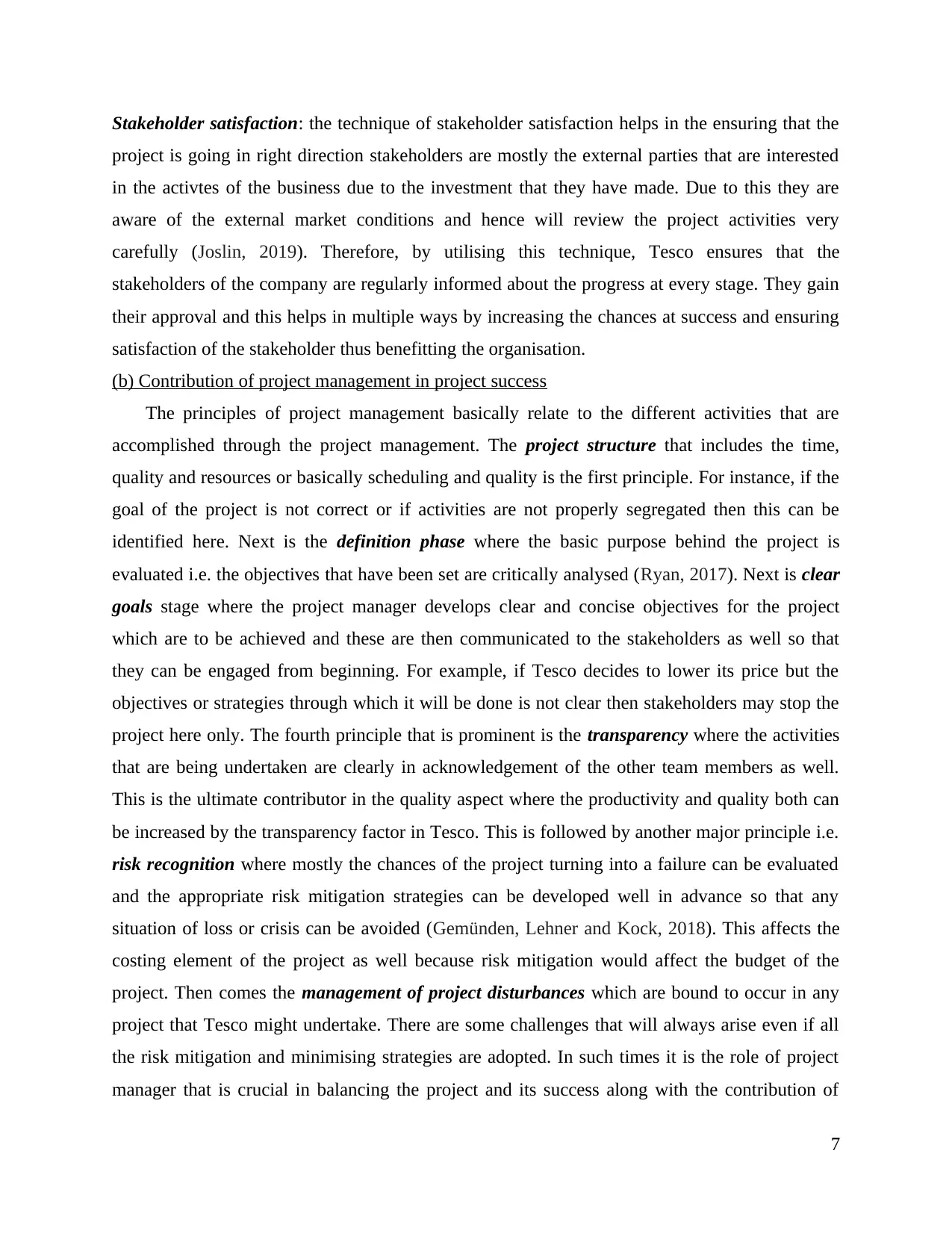
Stakeholder satisfaction: the technique of stakeholder satisfaction helps in the ensuring that the
project is going in right direction stakeholders are mostly the external parties that are interested
in the activtes of the business due to the investment that they have made. Due to this they are
aware of the external market conditions and hence will review the project activities very
carefully (Joslin, 2019). Therefore, by utilising this technique, Tesco ensures that the
stakeholders of the company are regularly informed about the progress at every stage. They gain
their approval and this helps in multiple ways by increasing the chances at success and ensuring
satisfaction of the stakeholder thus benefitting the organisation.
(b) Contribution of project management in project success
The principles of project management basically relate to the different activities that are
accomplished through the project management. The project structure that includes the time,
quality and resources or basically scheduling and quality is the first principle. For instance, if the
goal of the project is not correct or if activities are not properly segregated then this can be
identified here. Next is the definition phase where the basic purpose behind the project is
evaluated i.e. the objectives that have been set are critically analysed (Ryan, 2017). Next is clear
goals stage where the project manager develops clear and concise objectives for the project
which are to be achieved and these are then communicated to the stakeholders as well so that
they can be engaged from beginning. For example, if Tesco decides to lower its price but the
objectives or strategies through which it will be done is not clear then stakeholders may stop the
project here only. The fourth principle that is prominent is the transparency where the activities
that are being undertaken are clearly in acknowledgement of the other team members as well.
This is the ultimate contributor in the quality aspect where the productivity and quality both can
be increased by the transparency factor in Tesco. This is followed by another major principle i.e.
risk recognition where mostly the chances of the project turning into a failure can be evaluated
and the appropriate risk mitigation strategies can be developed well in advance so that any
situation of loss or crisis can be avoided (Gemünden, Lehner and Kock, 2018). This affects the
costing element of the project as well because risk mitigation would affect the budget of the
project. Then comes the management of project disturbances which are bound to occur in any
project that Tesco might undertake. There are some challenges that will always arise even if all
the risk mitigation and minimising strategies are adopted. In such times it is the role of project
manager that is crucial in balancing the project and its success along with the contribution of
7
project is going in right direction stakeholders are mostly the external parties that are interested
in the activtes of the business due to the investment that they have made. Due to this they are
aware of the external market conditions and hence will review the project activities very
carefully (Joslin, 2019). Therefore, by utilising this technique, Tesco ensures that the
stakeholders of the company are regularly informed about the progress at every stage. They gain
their approval and this helps in multiple ways by increasing the chances at success and ensuring
satisfaction of the stakeholder thus benefitting the organisation.
(b) Contribution of project management in project success
The principles of project management basically relate to the different activities that are
accomplished through the project management. The project structure that includes the time,
quality and resources or basically scheduling and quality is the first principle. For instance, if the
goal of the project is not correct or if activities are not properly segregated then this can be
identified here. Next is the definition phase where the basic purpose behind the project is
evaluated i.e. the objectives that have been set are critically analysed (Ryan, 2017). Next is clear
goals stage where the project manager develops clear and concise objectives for the project
which are to be achieved and these are then communicated to the stakeholders as well so that
they can be engaged from beginning. For example, if Tesco decides to lower its price but the
objectives or strategies through which it will be done is not clear then stakeholders may stop the
project here only. The fourth principle that is prominent is the transparency where the activities
that are being undertaken are clearly in acknowledgement of the other team members as well.
This is the ultimate contributor in the quality aspect where the productivity and quality both can
be increased by the transparency factor in Tesco. This is followed by another major principle i.e.
risk recognition where mostly the chances of the project turning into a failure can be evaluated
and the appropriate risk mitigation strategies can be developed well in advance so that any
situation of loss or crisis can be avoided (Gemünden, Lehner and Kock, 2018). This affects the
costing element of the project as well because risk mitigation would affect the budget of the
project. Then comes the management of project disturbances which are bound to occur in any
project that Tesco might undertake. There are some challenges that will always arise even if all
the risk mitigation and minimising strategies are adopted. In such times it is the role of project
manager that is crucial in balancing the project and its success along with the contribution of
7
Paraphrase This Document
Need a fresh take? Get an instant paraphrase of this document with our AI Paraphraser
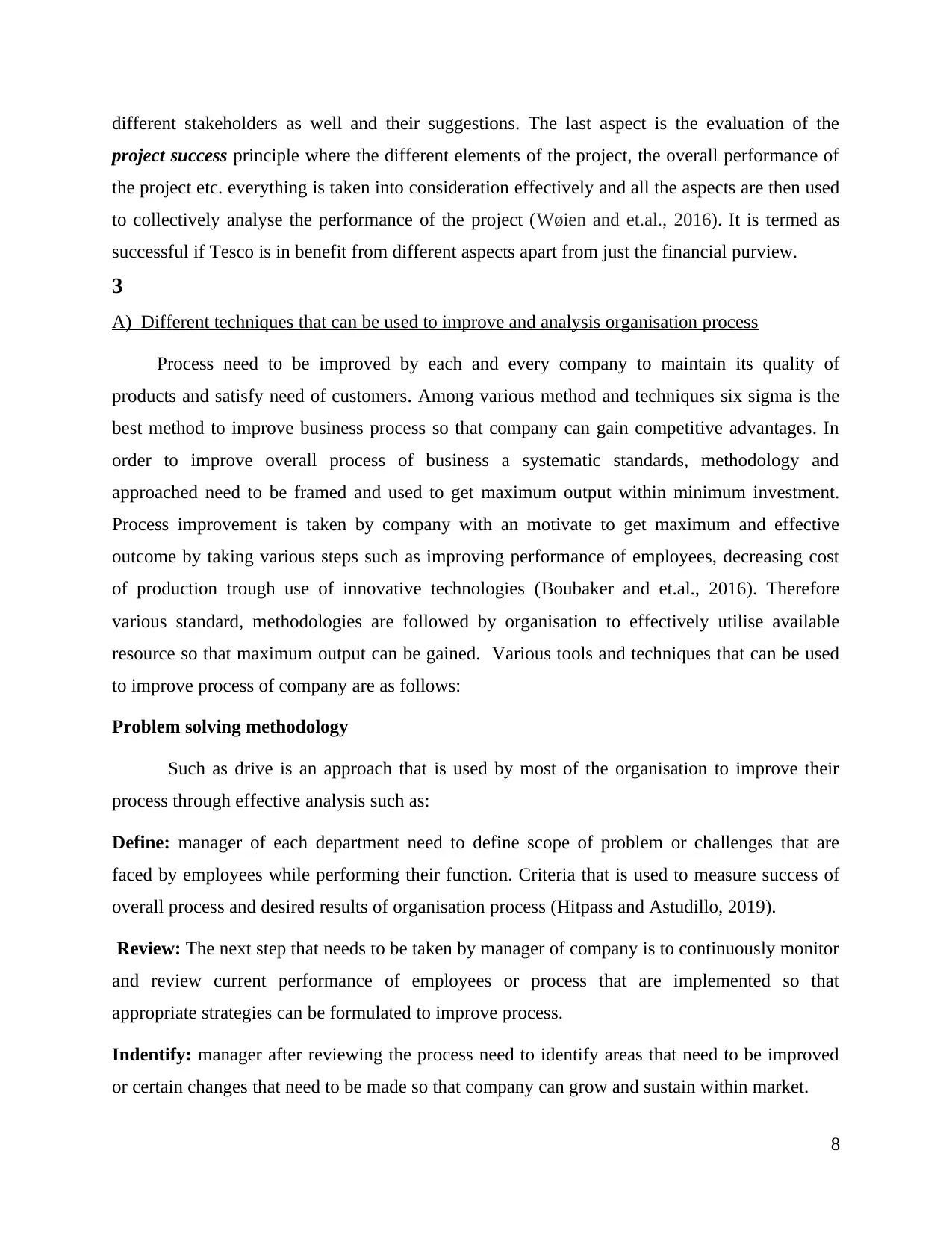
different stakeholders as well and their suggestions. The last aspect is the evaluation of the
project success principle where the different elements of the project, the overall performance of
the project etc. everything is taken into consideration effectively and all the aspects are then used
to collectively analyse the performance of the project (Wøien and et.al., 2016). It is termed as
successful if Tesco is in benefit from different aspects apart from just the financial purview.
3
A) Different techniques that can be used to improve and analysis organisation process
Process need to be improved by each and every company to maintain its quality of
products and satisfy need of customers. Among various method and techniques six sigma is the
best method to improve business process so that company can gain competitive advantages. In
order to improve overall process of business a systematic standards, methodology and
approached need to be framed and used to get maximum output within minimum investment.
Process improvement is taken by company with an motivate to get maximum and effective
outcome by taking various steps such as improving performance of employees, decreasing cost
of production trough use of innovative technologies (Boubaker and et.al., 2016). Therefore
various standard, methodologies are followed by organisation to effectively utilise available
resource so that maximum output can be gained. Various tools and techniques that can be used
to improve process of company are as follows:
Problem solving methodology
Such as drive is an approach that is used by most of the organisation to improve their
process through effective analysis such as:
Define: manager of each department need to define scope of problem or challenges that are
faced by employees while performing their function. Criteria that is used to measure success of
overall process and desired results of organisation process (Hitpass and Astudillo, 2019).
Review: The next step that needs to be taken by manager of company is to continuously monitor
and review current performance of employees or process that are implemented so that
appropriate strategies can be formulated to improve process.
Indentify: manager after reviewing the process need to identify areas that need to be improved
or certain changes that need to be made so that company can grow and sustain within market.
8
project success principle where the different elements of the project, the overall performance of
the project etc. everything is taken into consideration effectively and all the aspects are then used
to collectively analyse the performance of the project (Wøien and et.al., 2016). It is termed as
successful if Tesco is in benefit from different aspects apart from just the financial purview.
3
A) Different techniques that can be used to improve and analysis organisation process
Process need to be improved by each and every company to maintain its quality of
products and satisfy need of customers. Among various method and techniques six sigma is the
best method to improve business process so that company can gain competitive advantages. In
order to improve overall process of business a systematic standards, methodology and
approached need to be framed and used to get maximum output within minimum investment.
Process improvement is taken by company with an motivate to get maximum and effective
outcome by taking various steps such as improving performance of employees, decreasing cost
of production trough use of innovative technologies (Boubaker and et.al., 2016). Therefore
various standard, methodologies are followed by organisation to effectively utilise available
resource so that maximum output can be gained. Various tools and techniques that can be used
to improve process of company are as follows:
Problem solving methodology
Such as drive is an approach that is used by most of the organisation to improve their
process through effective analysis such as:
Define: manager of each department need to define scope of problem or challenges that are
faced by employees while performing their function. Criteria that is used to measure success of
overall process and desired results of organisation process (Hitpass and Astudillo, 2019).
Review: The next step that needs to be taken by manager of company is to continuously monitor
and review current performance of employees or process that are implemented so that
appropriate strategies can be formulated to improve process.
Indentify: manager after reviewing the process need to identify areas that need to be improved
or certain changes that need to be made so that company can grow and sustain within market.
8
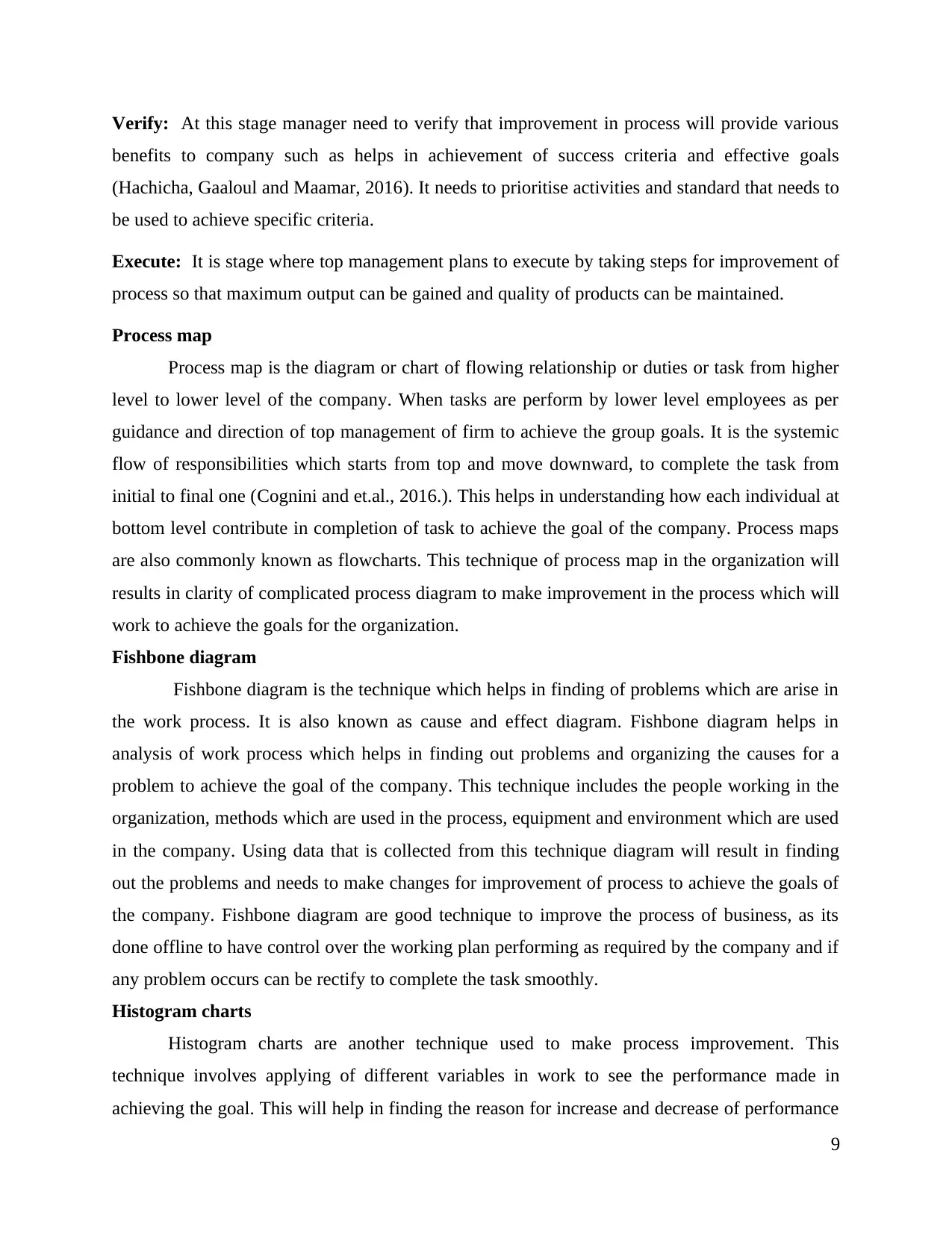
Verify: At this stage manager need to verify that improvement in process will provide various
benefits to company such as helps in achievement of success criteria and effective goals
(Hachicha, Gaaloul and Maamar, 2016). It needs to prioritise activities and standard that needs to
be used to achieve specific criteria.
Execute: It is stage where top management plans to execute by taking steps for improvement of
process so that maximum output can be gained and quality of products can be maintained.
Process map
Process map is the diagram or chart of flowing relationship or duties or task from higher
level to lower level of the company. When tasks are perform by lower level employees as per
guidance and direction of top management of firm to achieve the group goals. It is the systemic
flow of responsibilities which starts from top and move downward, to complete the task from
initial to final one (Cognini and et.al., 2016.). This helps in understanding how each individual at
bottom level contribute in completion of task to achieve the goal of the company. Process maps
are also commonly known as flowcharts. This technique of process map in the organization will
results in clarity of complicated process diagram to make improvement in the process which will
work to achieve the goals for the organization.
Fishbone diagram
Fishbone diagram is the technique which helps in finding of problems which are arise in
the work process. It is also known as cause and effect diagram. Fishbone diagram helps in
analysis of work process which helps in finding out problems and organizing the causes for a
problem to achieve the goal of the company. This technique includes the people working in the
organization, methods which are used in the process, equipment and environment which are used
in the company. Using data that is collected from this technique diagram will result in finding
out the problems and needs to make changes for improvement of process to achieve the goals of
the company. Fishbone diagram are good technique to improve the process of business, as its
done offline to have control over the working plan performing as required by the company and if
any problem occurs can be rectify to complete the task smoothly.
Histogram charts
Histogram charts are another technique used to make process improvement. This
technique involves applying of different variables in work to see the performance made in
achieving the goal. This will help in finding the reason for increase and decrease of performance
9
benefits to company such as helps in achievement of success criteria and effective goals
(Hachicha, Gaaloul and Maamar, 2016). It needs to prioritise activities and standard that needs to
be used to achieve specific criteria.
Execute: It is stage where top management plans to execute by taking steps for improvement of
process so that maximum output can be gained and quality of products can be maintained.
Process map
Process map is the diagram or chart of flowing relationship or duties or task from higher
level to lower level of the company. When tasks are perform by lower level employees as per
guidance and direction of top management of firm to achieve the group goals. It is the systemic
flow of responsibilities which starts from top and move downward, to complete the task from
initial to final one (Cognini and et.al., 2016.). This helps in understanding how each individual at
bottom level contribute in completion of task to achieve the goal of the company. Process maps
are also commonly known as flowcharts. This technique of process map in the organization will
results in clarity of complicated process diagram to make improvement in the process which will
work to achieve the goals for the organization.
Fishbone diagram
Fishbone diagram is the technique which helps in finding of problems which are arise in
the work process. It is also known as cause and effect diagram. Fishbone diagram helps in
analysis of work process which helps in finding out problems and organizing the causes for a
problem to achieve the goal of the company. This technique includes the people working in the
organization, methods which are used in the process, equipment and environment which are used
in the company. Using data that is collected from this technique diagram will result in finding
out the problems and needs to make changes for improvement of process to achieve the goals of
the company. Fishbone diagram are good technique to improve the process of business, as its
done offline to have control over the working plan performing as required by the company and if
any problem occurs can be rectify to complete the task smoothly.
Histogram charts
Histogram charts are another technique used to make process improvement. This
technique involves applying of different variables in work to see the performance made in
achieving the goal. This will help in finding the reason for increase and decrease of performance
9
You're viewing a preview
Unlock full access by subscribing today!
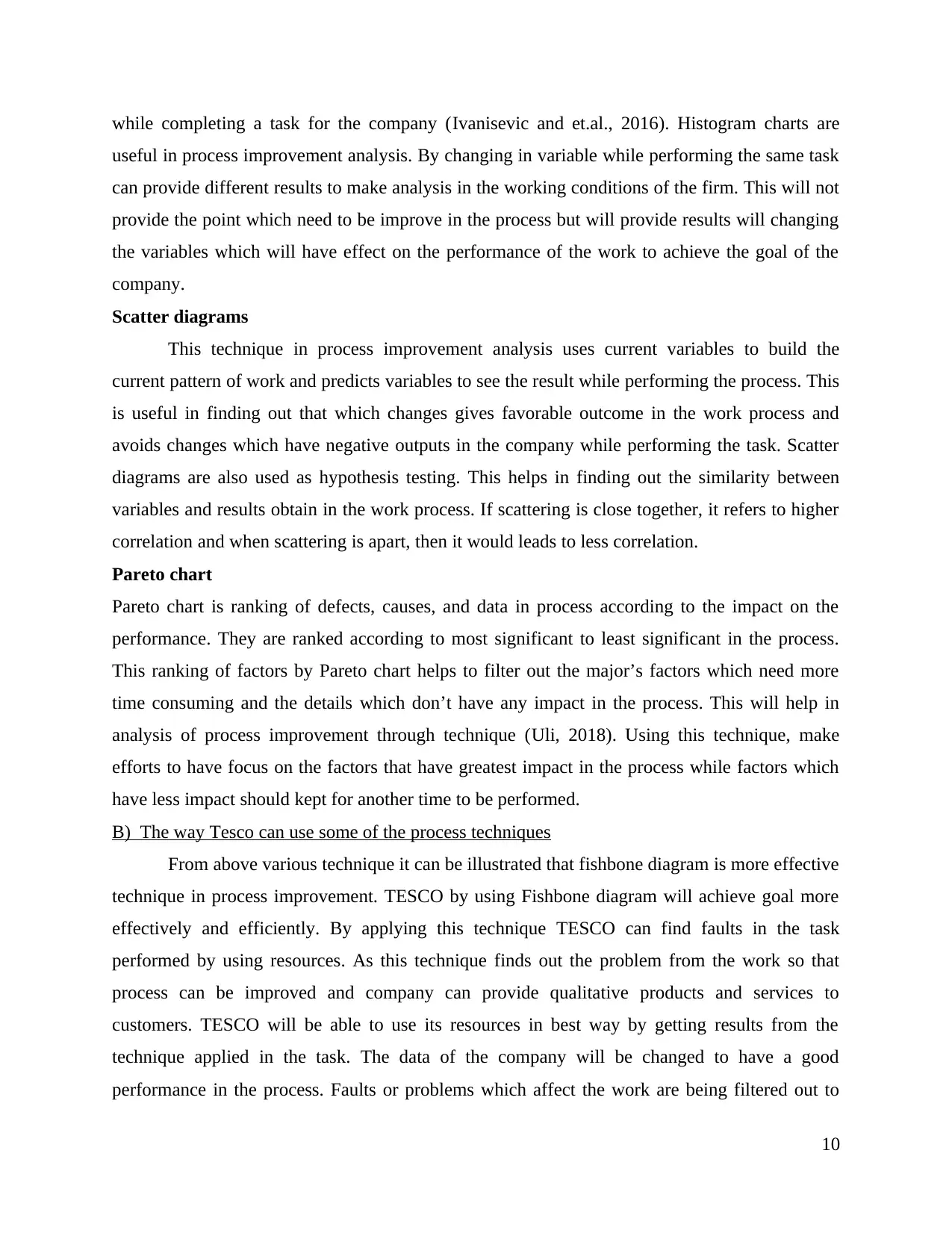
while completing a task for the company (Ivanisevic and et.al., 2016). Histogram charts are
useful in process improvement analysis. By changing in variable while performing the same task
can provide different results to make analysis in the working conditions of the firm. This will not
provide the point which need to be improve in the process but will provide results will changing
the variables which will have effect on the performance of the work to achieve the goal of the
company.
Scatter diagrams
This technique in process improvement analysis uses current variables to build the
current pattern of work and predicts variables to see the result while performing the process. This
is useful in finding out that which changes gives favorable outcome in the work process and
avoids changes which have negative outputs in the company while performing the task. Scatter
diagrams are also used as hypothesis testing. This helps in finding out the similarity between
variables and results obtain in the work process. If scattering is close together, it refers to higher
correlation and when scattering is apart, then it would leads to less correlation.
Pareto chart
Pareto chart is ranking of defects, causes, and data in process according to the impact on the
performance. They are ranked according to most significant to least significant in the process.
This ranking of factors by Pareto chart helps to filter out the major’s factors which need more
time consuming and the details which don’t have any impact in the process. This will help in
analysis of process improvement through technique (Uli, 2018). Using this technique, make
efforts to have focus on the factors that have greatest impact in the process while factors which
have less impact should kept for another time to be performed.
B) The way Tesco can use some of the process techniques
From above various technique it can be illustrated that fishbone diagram is more effective
technique in process improvement. TESCO by using Fishbone diagram will achieve goal more
effectively and efficiently. By applying this technique TESCO can find faults in the task
performed by using resources. As this technique finds out the problem from the work so that
process can be improved and company can provide qualitative products and services to
customers. TESCO will be able to use its resources in best way by getting results from the
technique applied in the task. The data of the company will be changed to have a good
performance in the process. Faults or problems which affect the work are being filtered out to
10
useful in process improvement analysis. By changing in variable while performing the same task
can provide different results to make analysis in the working conditions of the firm. This will not
provide the point which need to be improve in the process but will provide results will changing
the variables which will have effect on the performance of the work to achieve the goal of the
company.
Scatter diagrams
This technique in process improvement analysis uses current variables to build the
current pattern of work and predicts variables to see the result while performing the process. This
is useful in finding out that which changes gives favorable outcome in the work process and
avoids changes which have negative outputs in the company while performing the task. Scatter
diagrams are also used as hypothesis testing. This helps in finding out the similarity between
variables and results obtain in the work process. If scattering is close together, it refers to higher
correlation and when scattering is apart, then it would leads to less correlation.
Pareto chart
Pareto chart is ranking of defects, causes, and data in process according to the impact on the
performance. They are ranked according to most significant to least significant in the process.
This ranking of factors by Pareto chart helps to filter out the major’s factors which need more
time consuming and the details which don’t have any impact in the process. This will help in
analysis of process improvement through technique (Uli, 2018). Using this technique, make
efforts to have focus on the factors that have greatest impact in the process while factors which
have less impact should kept for another time to be performed.
B) The way Tesco can use some of the process techniques
From above various technique it can be illustrated that fishbone diagram is more effective
technique in process improvement. TESCO by using Fishbone diagram will achieve goal more
effectively and efficiently. By applying this technique TESCO can find faults in the task
performed by using resources. As this technique finds out the problem from the work so that
process can be improved and company can provide qualitative products and services to
customers. TESCO will be able to use its resources in best way by getting results from the
technique applied in the task. The data of the company will be changed to have a good
performance in the process. Faults or problems which affect the work are being filtered out to
10
Paraphrase This Document
Need a fresh take? Get an instant paraphrase of this document with our AI Paraphraser
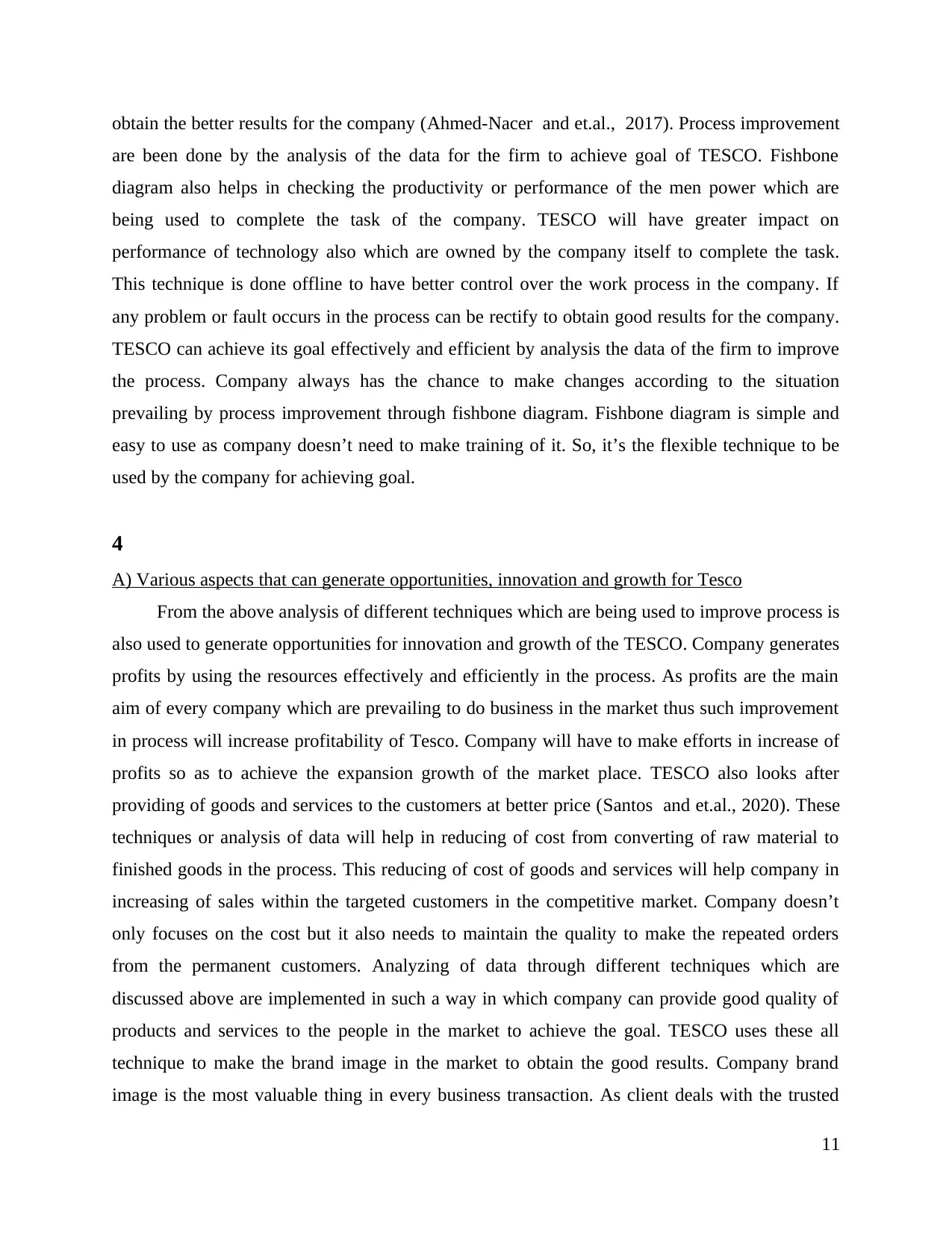
obtain the better results for the company (Ahmed-Nacer and et.al., 2017). Process improvement
are been done by the analysis of the data for the firm to achieve goal of TESCO. Fishbone
diagram also helps in checking the productivity or performance of the men power which are
being used to complete the task of the company. TESCO will have greater impact on
performance of technology also which are owned by the company itself to complete the task.
This technique is done offline to have better control over the work process in the company. If
any problem or fault occurs in the process can be rectify to obtain good results for the company.
TESCO can achieve its goal effectively and efficient by analysis the data of the firm to improve
the process. Company always has the chance to make changes according to the situation
prevailing by process improvement through fishbone diagram. Fishbone diagram is simple and
easy to use as company doesn’t need to make training of it. So, it’s the flexible technique to be
used by the company for achieving goal.
4
A) Various aspects that can generate opportunities, innovation and growth for Tesco
From the above analysis of different techniques which are being used to improve process is
also used to generate opportunities for innovation and growth of the TESCO. Company generates
profits by using the resources effectively and efficiently in the process. As profits are the main
aim of every company which are prevailing to do business in the market thus such improvement
in process will increase profitability of Tesco. Company will have to make efforts in increase of
profits so as to achieve the expansion growth of the market place. TESCO also looks after
providing of goods and services to the customers at better price (Santos and et.al., 2020). These
techniques or analysis of data will help in reducing of cost from converting of raw material to
finished goods in the process. This reducing of cost of goods and services will help company in
increasing of sales within the targeted customers in the competitive market. Company doesn’t
only focuses on the cost but it also needs to maintain the quality to make the repeated orders
from the permanent customers. Analyzing of data through different techniques which are
discussed above are implemented in such a way in which company can provide good quality of
products and services to the people in the market to achieve the goal. TESCO uses these all
technique to make the brand image in the market to obtain the good results. Company brand
image is the most valuable thing in every business transaction. As client deals with the trusted
11
are been done by the analysis of the data for the firm to achieve goal of TESCO. Fishbone
diagram also helps in checking the productivity or performance of the men power which are
being used to complete the task of the company. TESCO will have greater impact on
performance of technology also which are owned by the company itself to complete the task.
This technique is done offline to have better control over the work process in the company. If
any problem or fault occurs in the process can be rectify to obtain good results for the company.
TESCO can achieve its goal effectively and efficient by analysis the data of the firm to improve
the process. Company always has the chance to make changes according to the situation
prevailing by process improvement through fishbone diagram. Fishbone diagram is simple and
easy to use as company doesn’t need to make training of it. So, it’s the flexible technique to be
used by the company for achieving goal.
4
A) Various aspects that can generate opportunities, innovation and growth for Tesco
From the above analysis of different techniques which are being used to improve process is
also used to generate opportunities for innovation and growth of the TESCO. Company generates
profits by using the resources effectively and efficiently in the process. As profits are the main
aim of every company which are prevailing to do business in the market thus such improvement
in process will increase profitability of Tesco. Company will have to make efforts in increase of
profits so as to achieve the expansion growth of the market place. TESCO also looks after
providing of goods and services to the customers at better price (Santos and et.al., 2020). These
techniques or analysis of data will help in reducing of cost from converting of raw material to
finished goods in the process. This reducing of cost of goods and services will help company in
increasing of sales within the targeted customers in the competitive market. Company doesn’t
only focuses on the cost but it also needs to maintain the quality to make the repeated orders
from the permanent customers. Analyzing of data through different techniques which are
discussed above are implemented in such a way in which company can provide good quality of
products and services to the people in the market to achieve the goal. TESCO uses these all
technique to make the brand image in the market to obtain the good results. Company brand
image is the most valuable thing in every business transaction. As client deals with the trusted
11
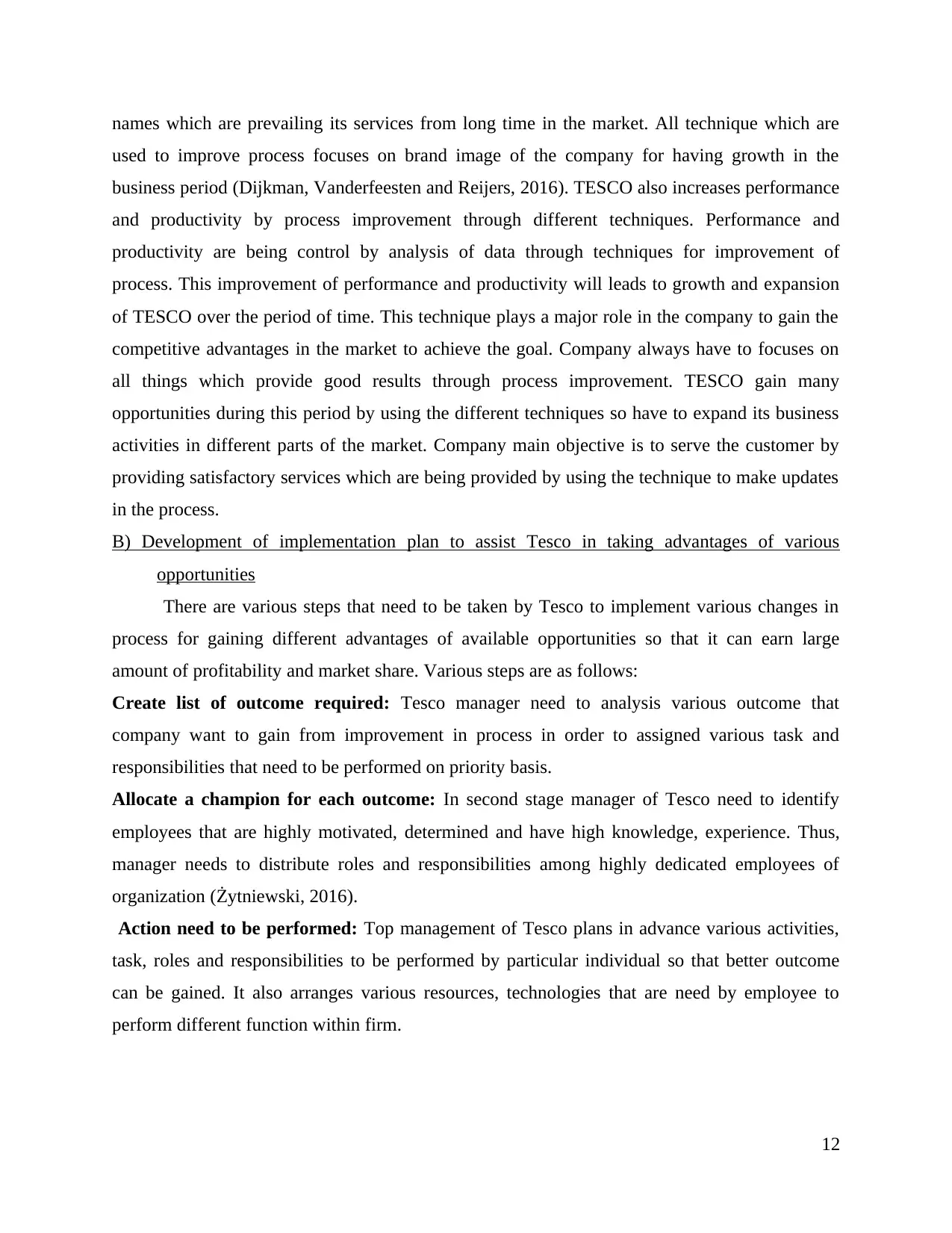
names which are prevailing its services from long time in the market. All technique which are
used to improve process focuses on brand image of the company for having growth in the
business period (Dijkman, Vanderfeesten and Reijers, 2016). TESCO also increases performance
and productivity by process improvement through different techniques. Performance and
productivity are being control by analysis of data through techniques for improvement of
process. This improvement of performance and productivity will leads to growth and expansion
of TESCO over the period of time. This technique plays a major role in the company to gain the
competitive advantages in the market to achieve the goal. Company always have to focuses on
all things which provide good results through process improvement. TESCO gain many
opportunities during this period by using the different techniques so have to expand its business
activities in different parts of the market. Company main objective is to serve the customer by
providing satisfactory services which are being provided by using the technique to make updates
in the process.
B) Development of implementation plan to assist Tesco in taking advantages of various
opportunities
There are various steps that need to be taken by Tesco to implement various changes in
process for gaining different advantages of available opportunities so that it can earn large
amount of profitability and market share. Various steps are as follows:
Create list of outcome required: Tesco manager need to analysis various outcome that
company want to gain from improvement in process in order to assigned various task and
responsibilities that need to be performed on priority basis.
Allocate a champion for each outcome: In second stage manager of Tesco need to identify
employees that are highly motivated, determined and have high knowledge, experience. Thus,
manager needs to distribute roles and responsibilities among highly dedicated employees of
organization (Żytniewski, 2016).
Action need to be performed: Top management of Tesco plans in advance various activities,
task, roles and responsibilities to be performed by particular individual so that better outcome
can be gained. It also arranges various resources, technologies that are need by employee to
perform different function within firm.
12
used to improve process focuses on brand image of the company for having growth in the
business period (Dijkman, Vanderfeesten and Reijers, 2016). TESCO also increases performance
and productivity by process improvement through different techniques. Performance and
productivity are being control by analysis of data through techniques for improvement of
process. This improvement of performance and productivity will leads to growth and expansion
of TESCO over the period of time. This technique plays a major role in the company to gain the
competitive advantages in the market to achieve the goal. Company always have to focuses on
all things which provide good results through process improvement. TESCO gain many
opportunities during this period by using the different techniques so have to expand its business
activities in different parts of the market. Company main objective is to serve the customer by
providing satisfactory services which are being provided by using the technique to make updates
in the process.
B) Development of implementation plan to assist Tesco in taking advantages of various
opportunities
There are various steps that need to be taken by Tesco to implement various changes in
process for gaining different advantages of available opportunities so that it can earn large
amount of profitability and market share. Various steps are as follows:
Create list of outcome required: Tesco manager need to analysis various outcome that
company want to gain from improvement in process in order to assigned various task and
responsibilities that need to be performed on priority basis.
Allocate a champion for each outcome: In second stage manager of Tesco need to identify
employees that are highly motivated, determined and have high knowledge, experience. Thus,
manager needs to distribute roles and responsibilities among highly dedicated employees of
organization (Żytniewski, 2016).
Action need to be performed: Top management of Tesco plans in advance various activities,
task, roles and responsibilities to be performed by particular individual so that better outcome
can be gained. It also arranges various resources, technologies that are need by employee to
perform different function within firm.
12
You're viewing a preview
Unlock full access by subscribing today!
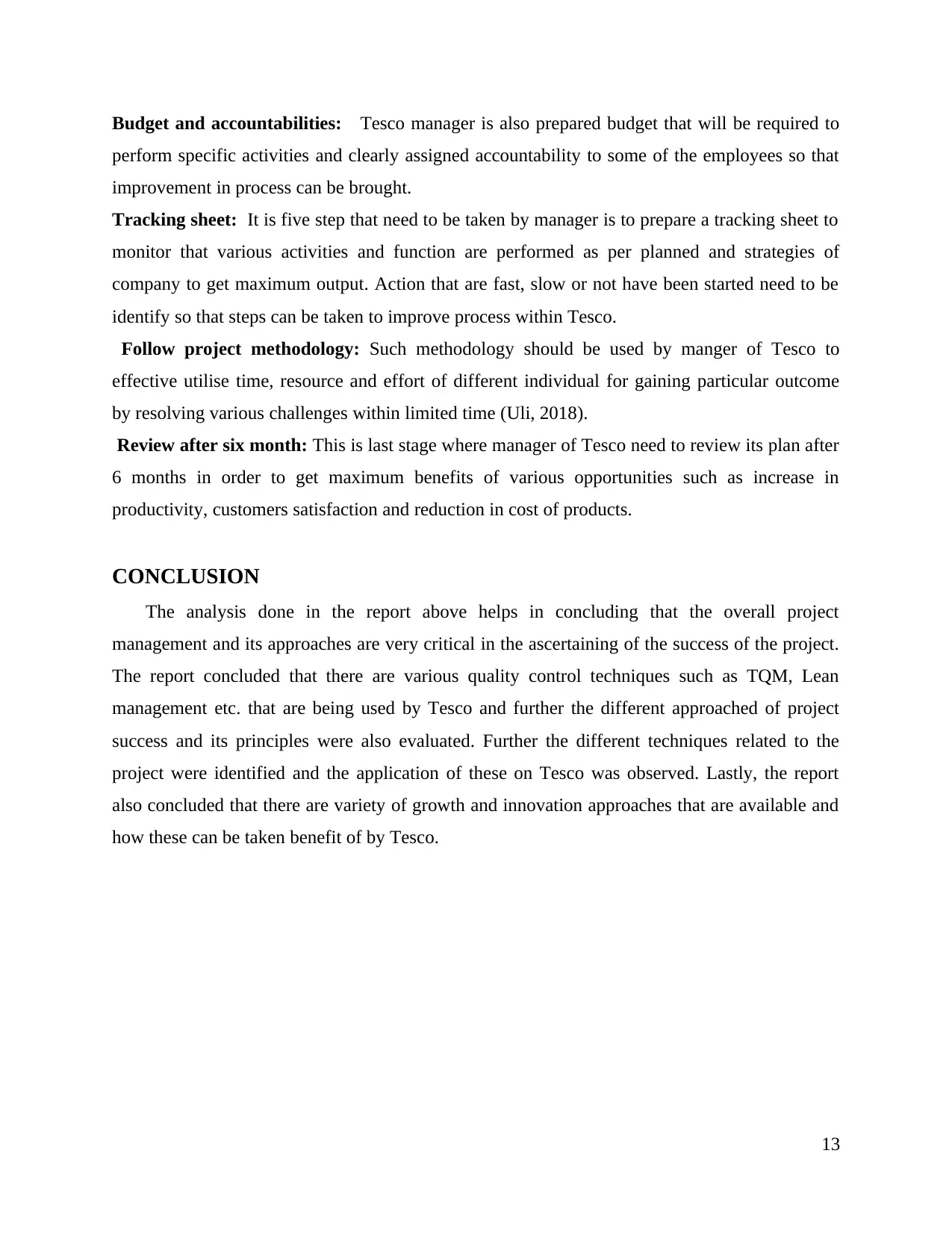
Budget and accountabilities: Tesco manager is also prepared budget that will be required to
perform specific activities and clearly assigned accountability to some of the employees so that
improvement in process can be brought.
Tracking sheet: It is five step that need to be taken by manager is to prepare a tracking sheet to
monitor that various activities and function are performed as per planned and strategies of
company to get maximum output. Action that are fast, slow or not have been started need to be
identify so that steps can be taken to improve process within Tesco.
Follow project methodology: Such methodology should be used by manger of Tesco to
effective utilise time, resource and effort of different individual for gaining particular outcome
by resolving various challenges within limited time (Uli, 2018).
Review after six month: This is last stage where manager of Tesco need to review its plan after
6 months in order to get maximum benefits of various opportunities such as increase in
productivity, customers satisfaction and reduction in cost of products.
CONCLUSION
The analysis done in the report above helps in concluding that the overall project
management and its approaches are very critical in the ascertaining of the success of the project.
The report concluded that there are various quality control techniques such as TQM, Lean
management etc. that are being used by Tesco and further the different approached of project
success and its principles were also evaluated. Further the different techniques related to the
project were identified and the application of these on Tesco was observed. Lastly, the report
also concluded that there are variety of growth and innovation approaches that are available and
how these can be taken benefit of by Tesco.
13
perform specific activities and clearly assigned accountability to some of the employees so that
improvement in process can be brought.
Tracking sheet: It is five step that need to be taken by manager is to prepare a tracking sheet to
monitor that various activities and function are performed as per planned and strategies of
company to get maximum output. Action that are fast, slow or not have been started need to be
identify so that steps can be taken to improve process within Tesco.
Follow project methodology: Such methodology should be used by manger of Tesco to
effective utilise time, resource and effort of different individual for gaining particular outcome
by resolving various challenges within limited time (Uli, 2018).
Review after six month: This is last stage where manager of Tesco need to review its plan after
6 months in order to get maximum benefits of various opportunities such as increase in
productivity, customers satisfaction and reduction in cost of products.
CONCLUSION
The analysis done in the report above helps in concluding that the overall project
management and its approaches are very critical in the ascertaining of the success of the project.
The report concluded that there are various quality control techniques such as TQM, Lean
management etc. that are being used by Tesco and further the different approached of project
success and its principles were also evaluated. Further the different techniques related to the
project were identified and the application of these on Tesco was observed. Lastly, the report
also concluded that there are variety of growth and innovation approaches that are available and
how these can be taken benefit of by Tesco.
13
Paraphrase This Document
Need a fresh take? Get an instant paraphrase of this document with our AI Paraphraser
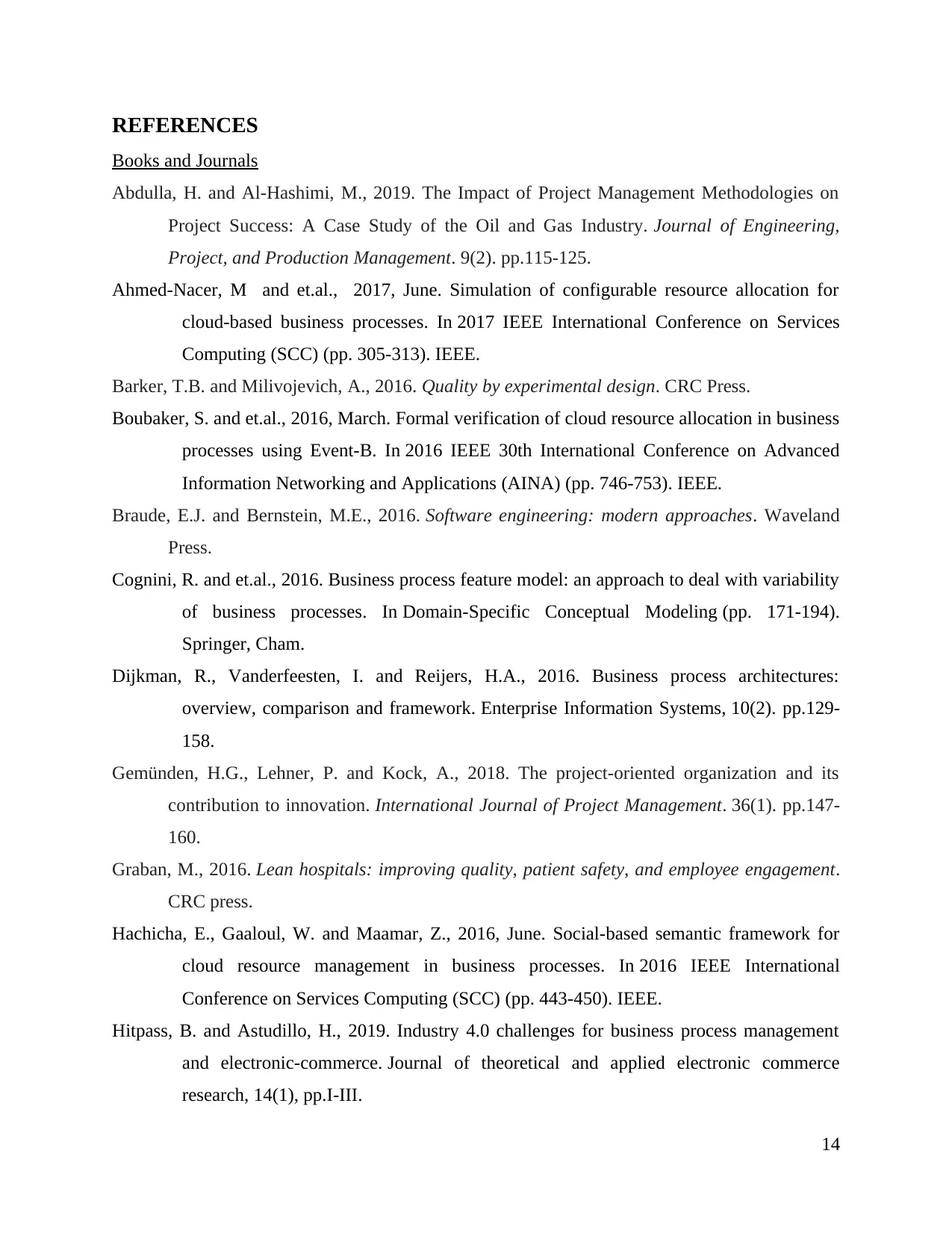
REFERENCES
Books and Journals
Abdulla, H. and Al-Hashimi, M., 2019. The Impact of Project Management Methodologies on
Project Success: A Case Study of the Oil and Gas Industry. Journal of Engineering,
Project, and Production Management. 9(2). pp.115-125.
Ahmed-Nacer, M and et.al., 2017, June. Simulation of configurable resource allocation for
cloud-based business processes. In 2017 IEEE International Conference on Services
Computing (SCC) (pp. 305-313). IEEE.
Barker, T.B. and Milivojevich, A., 2016. Quality by experimental design. CRC Press.
Boubaker, S. and et.al., 2016, March. Formal verification of cloud resource allocation in business
processes using Event-B. In 2016 IEEE 30th International Conference on Advanced
Information Networking and Applications (AINA) (pp. 746-753). IEEE.
Braude, E.J. and Bernstein, M.E., 2016. Software engineering: modern approaches. Waveland
Press.
Cognini, R. and et.al., 2016. Business process feature model: an approach to deal with variability
of business processes. In Domain-Specific Conceptual Modeling (pp. 171-194).
Springer, Cham.
Dijkman, R., Vanderfeesten, I. and Reijers, H.A., 2016. Business process architectures:
overview, comparison and framework. Enterprise Information Systems, 10(2). pp.129-
158.
Gemünden, H.G., Lehner, P. and Kock, A., 2018. The project-oriented organization and its
contribution to innovation. International Journal of Project Management. 36(1). pp.147-
160.
Graban, M., 2016. Lean hospitals: improving quality, patient safety, and employee engagement.
CRC press.
Hachicha, E., Gaaloul, W. and Maamar, Z., 2016, June. Social-based semantic framework for
cloud resource management in business processes. In 2016 IEEE International
Conference on Services Computing (SCC) (pp. 443-450). IEEE.
Hitpass, B. and Astudillo, H., 2019. Industry 4.0 challenges for business process management
and electronic-commerce. Journal of theoretical and applied electronic commerce
research, 14(1), pp.I-III.
14
Books and Journals
Abdulla, H. and Al-Hashimi, M., 2019. The Impact of Project Management Methodologies on
Project Success: A Case Study of the Oil and Gas Industry. Journal of Engineering,
Project, and Production Management. 9(2). pp.115-125.
Ahmed-Nacer, M and et.al., 2017, June. Simulation of configurable resource allocation for
cloud-based business processes. In 2017 IEEE International Conference on Services
Computing (SCC) (pp. 305-313). IEEE.
Barker, T.B. and Milivojevich, A., 2016. Quality by experimental design. CRC Press.
Boubaker, S. and et.al., 2016, March. Formal verification of cloud resource allocation in business
processes using Event-B. In 2016 IEEE 30th International Conference on Advanced
Information Networking and Applications (AINA) (pp. 746-753). IEEE.
Braude, E.J. and Bernstein, M.E., 2016. Software engineering: modern approaches. Waveland
Press.
Cognini, R. and et.al., 2016. Business process feature model: an approach to deal with variability
of business processes. In Domain-Specific Conceptual Modeling (pp. 171-194).
Springer, Cham.
Dijkman, R., Vanderfeesten, I. and Reijers, H.A., 2016. Business process architectures:
overview, comparison and framework. Enterprise Information Systems, 10(2). pp.129-
158.
Gemünden, H.G., Lehner, P. and Kock, A., 2018. The project-oriented organization and its
contribution to innovation. International Journal of Project Management. 36(1). pp.147-
160.
Graban, M., 2016. Lean hospitals: improving quality, patient safety, and employee engagement.
CRC press.
Hachicha, E., Gaaloul, W. and Maamar, Z., 2016, June. Social-based semantic framework for
cloud resource management in business processes. In 2016 IEEE International
Conference on Services Computing (SCC) (pp. 443-450). IEEE.
Hitpass, B. and Astudillo, H., 2019. Industry 4.0 challenges for business process management
and electronic-commerce. Journal of theoretical and applied electronic commerce
research, 14(1), pp.I-III.
14
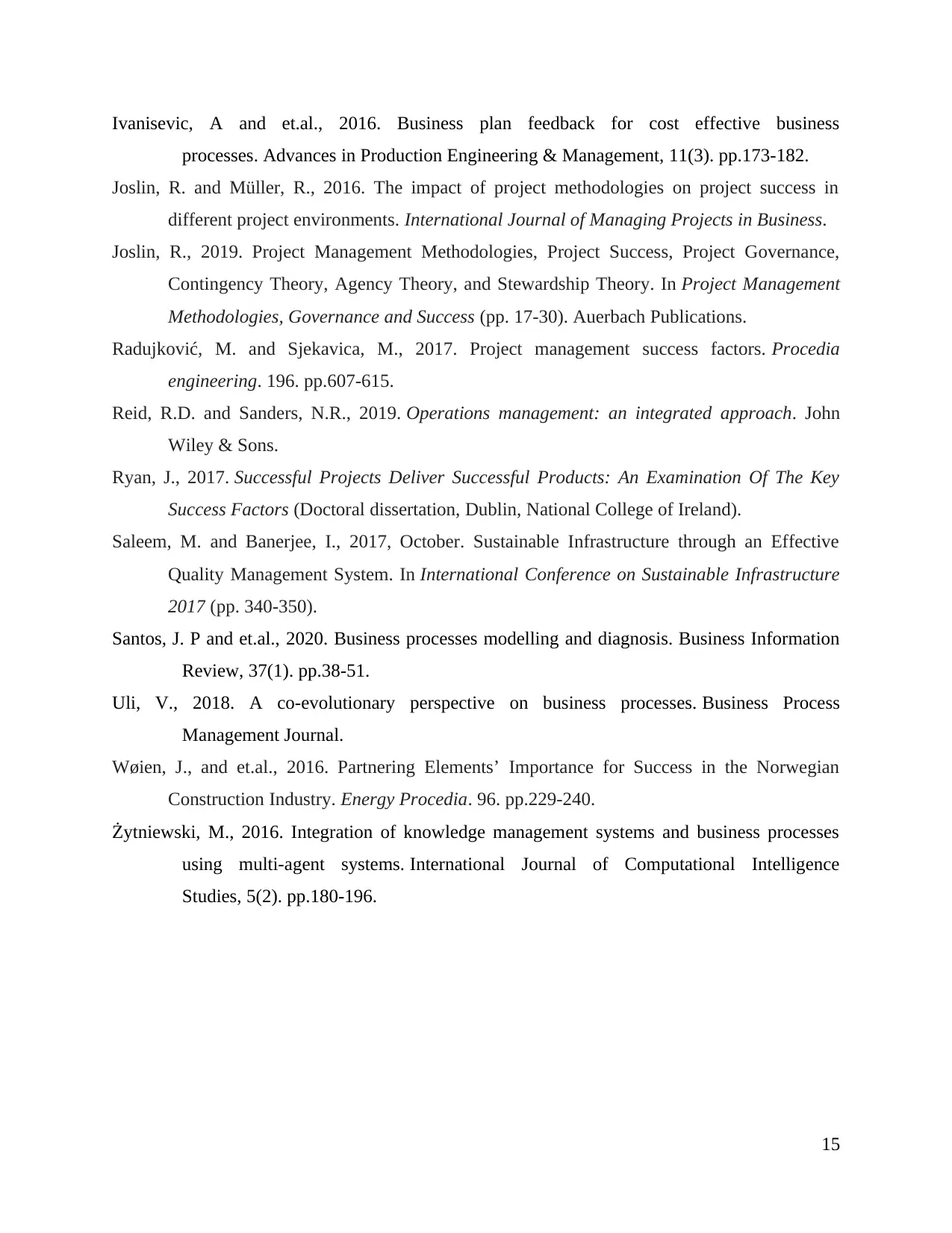
Ivanisevic, A and et.al., 2016. Business plan feedback for cost effective business
processes. Advances in Production Engineering & Management, 11(3). pp.173-182.
Joslin, R. and Müller, R., 2016. The impact of project methodologies on project success in
different project environments. International Journal of Managing Projects in Business.
Joslin, R., 2019. Project Management Methodologies, Project Success, Project Governance,
Contingency Theory, Agency Theory, and Stewardship Theory. In Project Management
Methodologies, Governance and Success (pp. 17-30). Auerbach Publications.
Radujković, M. and Sjekavica, M., 2017. Project management success factors. Procedia
engineering. 196. pp.607-615.
Reid, R.D. and Sanders, N.R., 2019. Operations management: an integrated approach. John
Wiley & Sons.
Ryan, J., 2017. Successful Projects Deliver Successful Products: An Examination Of The Key
Success Factors (Doctoral dissertation, Dublin, National College of Ireland).
Saleem, M. and Banerjee, I., 2017, October. Sustainable Infrastructure through an Effective
Quality Management System. In International Conference on Sustainable Infrastructure
2017 (pp. 340-350).
Santos, J. P and et.al., 2020. Business processes modelling and diagnosis. Business Information
Review, 37(1). pp.38-51.
Uli, V., 2018. A co-evolutionary perspective on business processes. Business Process
Management Journal.
Wøien, J., and et.al., 2016. Partnering Elements’ Importance for Success in the Norwegian
Construction Industry. Energy Procedia. 96. pp.229-240.
Żytniewski, M., 2016. Integration of knowledge management systems and business processes
using multi-agent systems. International Journal of Computational Intelligence
Studies, 5(2). pp.180-196.
15
processes. Advances in Production Engineering & Management, 11(3). pp.173-182.
Joslin, R. and Müller, R., 2016. The impact of project methodologies on project success in
different project environments. International Journal of Managing Projects in Business.
Joslin, R., 2019. Project Management Methodologies, Project Success, Project Governance,
Contingency Theory, Agency Theory, and Stewardship Theory. In Project Management
Methodologies, Governance and Success (pp. 17-30). Auerbach Publications.
Radujković, M. and Sjekavica, M., 2017. Project management success factors. Procedia
engineering. 196. pp.607-615.
Reid, R.D. and Sanders, N.R., 2019. Operations management: an integrated approach. John
Wiley & Sons.
Ryan, J., 2017. Successful Projects Deliver Successful Products: An Examination Of The Key
Success Factors (Doctoral dissertation, Dublin, National College of Ireland).
Saleem, M. and Banerjee, I., 2017, October. Sustainable Infrastructure through an Effective
Quality Management System. In International Conference on Sustainable Infrastructure
2017 (pp. 340-350).
Santos, J. P and et.al., 2020. Business processes modelling and diagnosis. Business Information
Review, 37(1). pp.38-51.
Uli, V., 2018. A co-evolutionary perspective on business processes. Business Process
Management Journal.
Wøien, J., and et.al., 2016. Partnering Elements’ Importance for Success in the Norwegian
Construction Industry. Energy Procedia. 96. pp.229-240.
Żytniewski, M., 2016. Integration of knowledge management systems and business processes
using multi-agent systems. International Journal of Computational Intelligence
Studies, 5(2). pp.180-196.
15
You're viewing a preview
Unlock full access by subscribing today!

16
1 out of 16
Related Documents
Your All-in-One AI-Powered Toolkit for Academic Success.
+13062052269
info@desklib.com
Available 24*7 on WhatsApp / Email
![[object Object]](/_next/static/media/star-bottom.7253800d.svg)
Unlock your academic potential
© 2024 | Zucol Services PVT LTD | All rights reserved.





